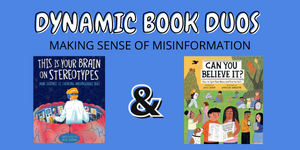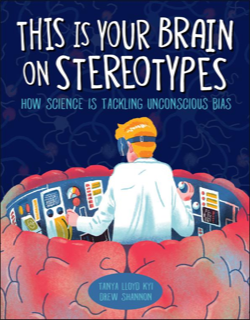
Please welcome authors Joyce Grant and Tanya Lloyd Kyi to Dynamic Book Duos– a blog featuring two books that pair together in a meaningful way along with coordinating educational activities to strengthen reading skills. This week’s Dynamic Book Duos pair focuses on making sense of misinformation.
PERFECT PAIRS: Making Sense of Misinformation
Information today comes at us all like water from a firehose. How can we help kids make sense of it all? Can You Believe It?: How to Spot Fake News and Find the Facts written by Joyce Grant and illustrated by Kathleen Marcotte and This is Your Brain on Stereotypes: How Science is Tackling Unconscious Bias written by Tanya Lloyd Kyi and illustrated by Drew Shannon help kids think critically about what they see online and how to spot missing or underrepresented points of view, al well as misinformation. Best of all, they do it with a sense of humor and deep respect for the young reader.
BOOK 1: This is Your Brain on Stereotypes

THIS YOUR BRAIN ON STEREOTYPES helps young readers make sense of why we classify people, and how we might change our thinking. It covers the history of stereotype research, the existence of secret biases in our brains, and the ways stereotypes affect our sense of self. Most importantly, it shows how science can help us overcome our biases. The books offers hope for a future where the world is more fair for everyone.
Written by award-winning author Tanya Lloyd Kyi, this timely and hopeful book addresses the issues of discrimination, racism, sexism, ableism and homophobia and offers concrete suggestions on how to make change. It uses scientific inquiry and loads of relatable and interesting examples to explore these uncomfortable topics in age-appropriate and engaging ways.
BOOK 2: Can You Believe It?

Should we believe everything we read online? Definitely not! And CAN YOU BELIEVE IT? will tell you why. This fascinating book explores in depth how real journalism is made, what “fake news” is and, most importantly, how to spot the difference. It’s chock-full of practical advice, thought-provoking examples and tons of relevant information on subjects that range from bylines and credible sources to influencers and clickbait.
Author and journalist Joyce Grant is an expert on how young people interact with and think about online media. Never judgmental, and often hilarious, she encourages readers to approach what they find online with skepticism and helps them hone their critical thinking skills to make good choices about what to believe and share.
Educational Activities for Both Books
Part I
Practice Your Point of View
A major league baseball player just hit the ball out of the park! Crack—whoosh! What are the following thinking or feeling?
- The batter who hit the home run
- The pitcher who pitched the ball that got hit
- The hot dog vendor, working in the hot sun
- An elderly fan in the stands sitting beside three young baseball fans
- A neighbour who lives behind the ballpark
- The swallows who nest on top of the stadium lights.
- The baseball itself (if it could think/feel), or the bat
- The mascot, wearing a thick dragon suit.
- You, at home, watching the game on TV
Point of View Rewrite
Read the following news article:
City workers this week cut down the weeds from a nuisance garden on sixth avenue. Neighbors said the plants have been growing wild for years, but the homeowner refused to cut them.
“She kept nattering on about butterflies,” said one neighbour.
City bylaws require that gardens be well tended. A city council representative confirmed that untended gardens can be mowed at the homeowner’s expense.
- Try writing this story from the point of view of the gardener.
- Now, try writing it from the point of view of a butterfly expert.
- How did the story change?
You Be the Editor
Choose a magazine or a newspaper. Flip through it and see if there is a balance of:
- Genders
- Body types; and
- Ethnicities represented throughout it.
Part II
Find one specific news article online or in a newspaper or magazine and read it.
See if you can find examples of:
- An error or inaccuracy
- Missing point-of-view
- Bias
- Stereotypes
- Click-bait or sensationalism
Influencers
You are an expert chef who has just been given a brand new pink ice cream maker called the SWEET SCOOP. In the box was $200 worth of SWEET SCOOP merchandise: t-shirts, hats, a frilly apron, bowls with unicorn images and other fun, branded stuff.
- Say something good about the new ice cream maker.
- Now say something you don’t like about the new ice cream maker.
- Which comment would you be more inclined to post on your social media? Why did you choose that one?
- Is there anything about the branding that might make some people more (or less) likely to use this product or wear the merchandise
Who Wrote This
Read a short column or opinion piece (an article that is meant to persuade the reader).
- What is the author’s opinion?
- What in the article tells you that?
INTERVIEWING
Interview six people about whether professional men’s soccer players should be paid the same as professional women’s soccer players.
- What is your own opinion?
- Find some news stories about this issue. Can you see any biases in those stories?
- Did your own opinion influence how you felt about other people’s opinions?
- What other information will you gather, to ensure you get all sides to this story and represent everyone’s point of view?
GET YOUR SCHOOL INVOLVED
Draw posters about fake news or stereotypes to display on your school bulletin board.
Or, help your librarian create a book display with these and other books that help you think critically and break stereotypes.
COMPREHENSION QUESTIONS
- What is “fake news”?
- What is “bias”?
- Why do people create fake news?
- Why do people have biases?
- What can you do about fake news?
- What can you do to help people break their stereotypes?
- Is it possible for a journalist to have an accidental bias? Is it possible for a journalist to be completely unbiased? Discuss.
ADDITIONAL RESOURCES

